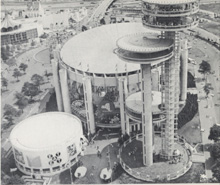
Guard it well Mr. Mayor and Mr. Park’s Commissioner. Flushing Meadows has echoed to the sounds of many footsteps and voices. The world has beaten a path to its doors. Now we return it to the natives.
Robert Moses July 23, 1965
As early as 1967 Nathan Silver, author of Lost New York, championed the preservation of the New York State Pavilion as the only “distinguished work of architecture” amid the “witless and savage” at the Fair. Heralded in its time by the critics and largely forgotten today, the Pavilion is a landmark in every sense: of the Fair, New York, and the decade. It is as one recent critic wrote, “the Eiffel Tower of Queens.”
Today preservation of the recent past is front page news and the debate has raised the question of whether such works of art and architecture require different principles or at least different practices of conservation from those developed for older or more traditional heritage. The recent past can now be safely relegated to the proceeding century, yet how much time must pass for a building or site to qualify for heritage status? Age alone is immaterial in establishing historical significance unless rarity prevails. However age does establish a critical distance from the present, deemed necessary for historical evaluation. How buildings and sites are received by each generation depends on the specific conditions of time and place.
With the recognition of the Post-Modern around 1960, the Modern Movement now has an end date and a temporal and ideological distance has been established thus transforming these buildings into potential “heritage.” Despite modernity’s variety of expressions, preservation of the “recent past” has tended to focus on the avant-garde, the monuments of “experimental modernism” rather than its contemporaneous “mainstream.” Both the recognition of the end of the modern period and the preferential selection of certain avant-garde work as representing the period based on historiographical hindsight is partly responsible for the current ambiguities in recent efforts to preserve buildings and sites from the 1960s and 70s.
As for the future of the Pavilion, recent proposals have suggested a visitor center, a museum of the Fairs, and an aerospace museum. Johnson himself was open to the possibilities of its display as a stabilized ruin. Whatever approach is taken, the Pavilion and its great road map pavement remain vital symbols of the “World of Tomorrow” that came and went over forty years ago.